Sujata Shah is a graphic designer, textile artist, author and teacher. Originally from Mumbai, India, Sujata now lives with her family in the US. Sujata has won numerous awards for her quilts in local and national quilt shows, and her quilt designs have been taught and replicated all over the world. In 2003, Sujata discovered an instant connection between the abstract utilitarian quilts of Gee’s Bend and Godharis from her native India. Her instinctive ability to work with colors and textures, combined with an education in graphic design, has helped her develop a unique style as a designer. She draws her inspirations from imperfections and irregularities of free-spirited folk art and crafts from around the world. In 2014, she wrote the book, Cultural Fusion Quilts: A Melting Pot of Piecing Traditions, in which she introduced free-form blocks and abstract interpretations of traditional quilt blocks. In addition to teaching worldwide, Sujata is the host of the Handmade India tour with designer Amy Butler. The tour offers an intimate cultural immersion experience in India that combines creative workshops led by local artisans with the exploration of historic temples, palaces and markets in Jaipur, India. Welcome, Sujata!

How would you describe your quilting style/aesthetic?
Sujata: As a graphic designer, I like the idea of making bold statements with color and scale. There is a strong connection between the mindset of a maker and the maker’s art. I find great comfort in acceptance of imperfections and irregularities of handmade crafts. My aesthetic reflects who I am as a person. Two highly contrasting cultures, Indian and American, have defined me and my perfectly imperfect quilts.
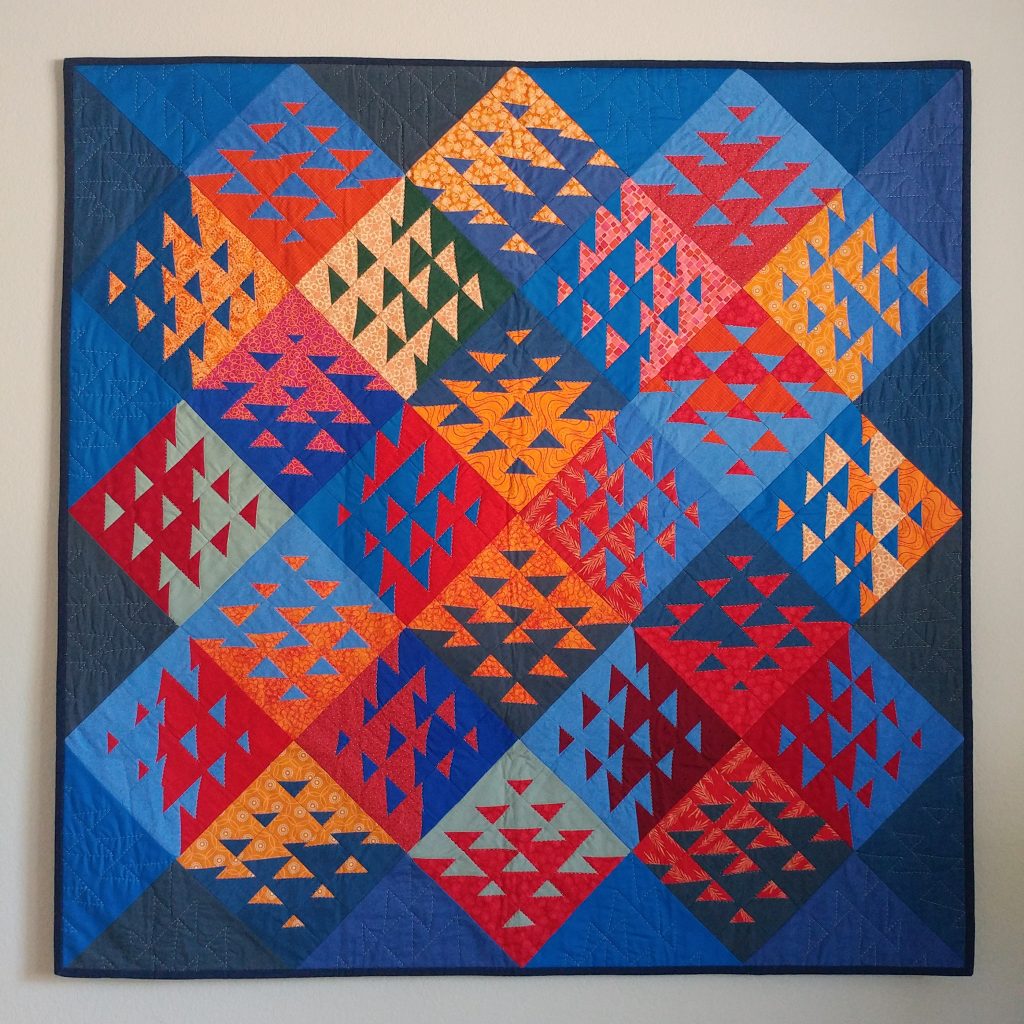
Sunset. This quilt is the physical embodiment of Sujata’s memories and emotions about her father. She dedicated it’s making to her father who wanted to see her succeed as an artist. Made in 2009. Image courtesy of Sujata Shah.
How would you describe the creative environment in your home as a child?
Sujata: I grew up in India surrounded with a tapestry of rich colors, textiles and handmade crafts. My mother was not a quilter but was quite creative when it came to cooking, crafting and sewing. She was the best at “making do.” I watched her turn old garments into household goods like godharis (Indian quilts) and bags. She hand-embroidered many of her saris in her spare time. My parents recognized my interest in art early on and encouraged me to continue my passion. Drawing on the backs of pages of large wall calendars was my favorite way to pass time. Basic art materials like crayons, watercolor tubes, paper, and strings were always on hand. Using razor blades as carving tool and broken pieces of bangles, mirror and cardboard to make a kaleidoscope was a “normal” thing in our home. My father proudly shared my work with anyone and everyone who showed interest. I think that instilled the idea that I had special skills and that encouraged me to be creative.

Mom and I. This quilt was made documenting Sujata’s time with her mother during her mother’s recovery from stroke. Image courtesy of Sujata Shah.
What artists and makers do you most admire or have an influence on your work?
Sujata: I must acknowledge generations of artisans and makers around the world when it comes to providing pattern inspirations through handmade crafts. While working in a quilt shop, I was exposed to many artists and complicated patterns through quilt books, but I always found the repetition of simple shapes and forms comforting. They reminded me of utilitarian godharis, whole cloth Kantha quilts, and patchwork Ralli quilts of India. Quilts of the Deep South and American folk art played a major role in shaping me as the quilter I am today, too. Women and quilts of Gee’s Bend made a permanent shift in my quilting journey. Quilters of Gee’s Bend and India had one thing in common – they were making quilts with materials they had on hand, without needing perfection. “Making do,” creating without fuss, and making bold statements with colors have become the focal point of my creative journey. Gwen Marston and Freddy Moran set the path for me when it comes to perfectly imperfect quilts, breaking traditions and making it okay, and exciting, to be different.

Confetti. Handquilted strictly scraps using scissors. Image courtesy of Sujata Shah.
Do you consider yourself a “quilter”, an artist, or some combination of both?
Sujata: I would say both. Being an artist has always been part of my being. What I see, both in nature and in my surroundings, teaches me lessons I apply in my quilts. Growing up, I did not like sewing, but I was crafty. I studied calligraphy, photography, printmaking, and illustration in art school and became a graphic designer. After moving to this country I realized that fabric, needle and thread are also various mediums to create another form of art. For me, decorating my home, cooking, cleaning, or gardening are all expressions of art.
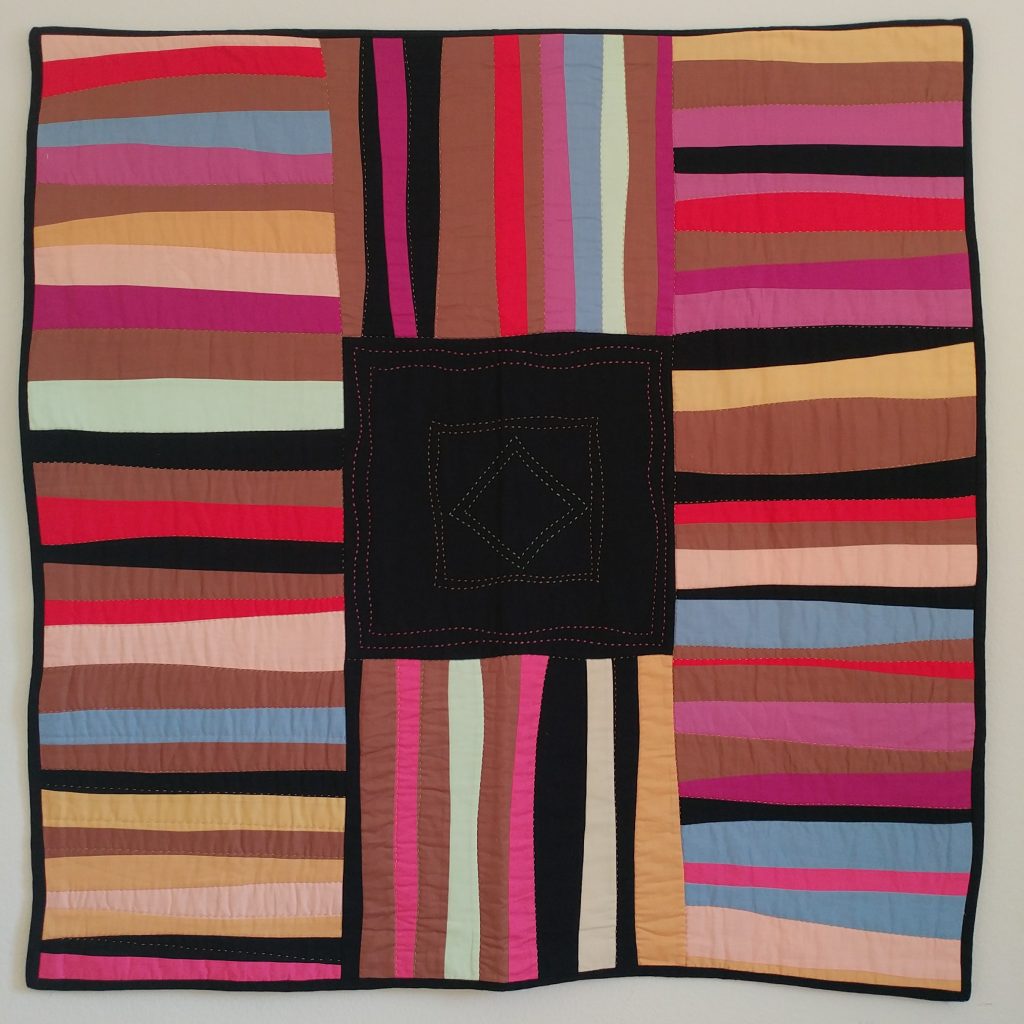
Town Square. Image courtesy of Sujata Shah.
How would you define “making with intention”?
Sujata: This subject is very close to my heart. I feel very connected to the idea of “making do.” Around the world, quilts made from the humble materials are celebrated; they grace the walls of museums and art galleries. Their maker’s intentions were simple – winter was around the corner and people needed to be warm. In the process of making quilts, though, they were expressing their individual and unique artistic sense. They were not guided by what everyone else wanted, they were making what they needed and desired. I do the same thing. Sometimes I make a quilt for a story I want to tell and sometimes I have emotions I want to document through stitching. I cut fabrics with gentle curves, use multiple shades of the same color to achieve worn and weathered look and hand quilt with heavy running stitch to pay homage to Indian quilts. My intention is always to keep my quilts visually engaging; with colors, textures and organic lines.
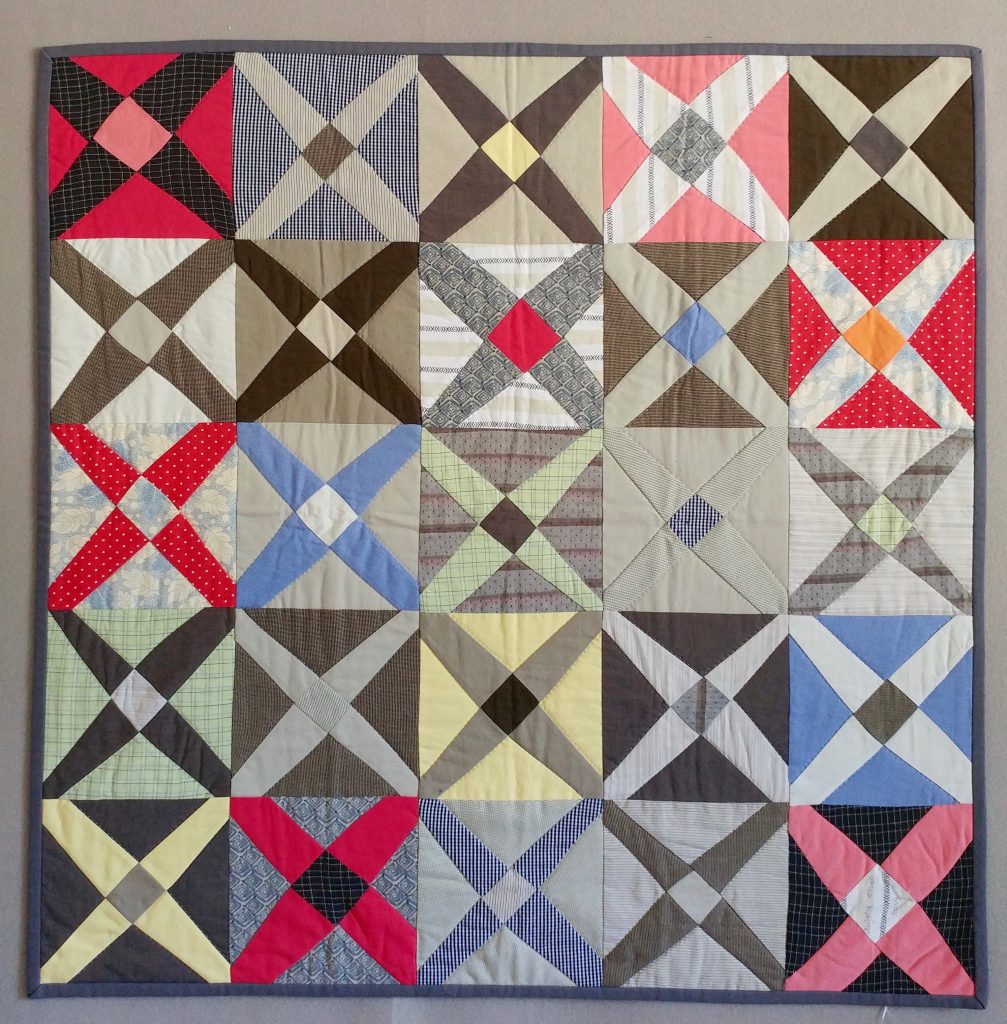
Crossroads 2013. Quilt made with recycled fabrics. Image courtesy of Sujata Shah.
Do you think that having a craft makes us more compassionate? If so, then how?
Sujata: Crafting is a thread that connects us all together in creative world. In today’s fast-paced life, it is important to be compassionate now more than ever. Everyone has a story to tell and we all need an ear every now and then. Quilt guilds and quilting groups provide a platform to share creativity, do charitable work, and to find friendships. My recent experience with Amy Butler on our Handmade India Tour is a perfect example of crafting for compassion. Our group of 13 guests spent a major chunk of one day circled around the table making malas (prayer bead necklace) and sharing stories of our lives. It brought us all together as a community of people, connecting with perfect strangers and caring for one another to form friendships for life.

Malas. Prayer beads made with the Handmade India tour that Sujata hosts with Amy Butler. Image courtesy of Sujata Shah.
How does creating feed your soul/spiritual purpose?
Sujata: Making a craft creates focus; it slows me down, calms my mind, and creates space to reflect. It also measures my life in stitches. Between a hectic teaching schedule and travels, I find balance at home by working on my own projects. When I am making a quilt I often find myself so engrossed in the process that I become only an instrument. The quilt takes life of its own and I become a medium through which it evolves. I consider that as a spiritual experience.
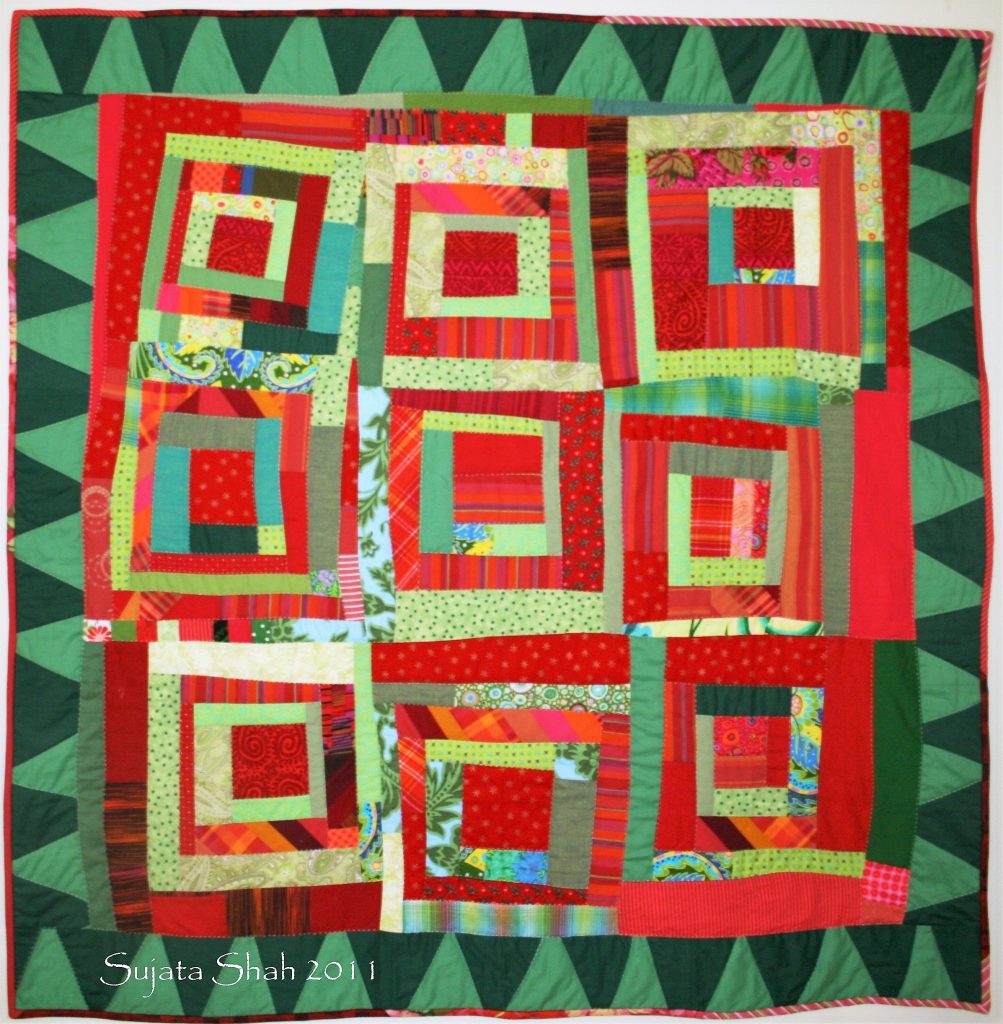
House Top and Pine Trees. Image courtesy of Sujata Shah.
Are there any rituals that you perform to prepare/ground yourself in your work?
Sujata: No. Making of a quilt is triggered by a conversation, a memory, or the simple need to create. I find it necessary to engage my mind and body in something productive, to spend time more fruitfully and to have a meditative experience on a daily basis. When that ‘need’ is triggered, the simplest act of putting patches of fabric together in eye pleasing way is enough.
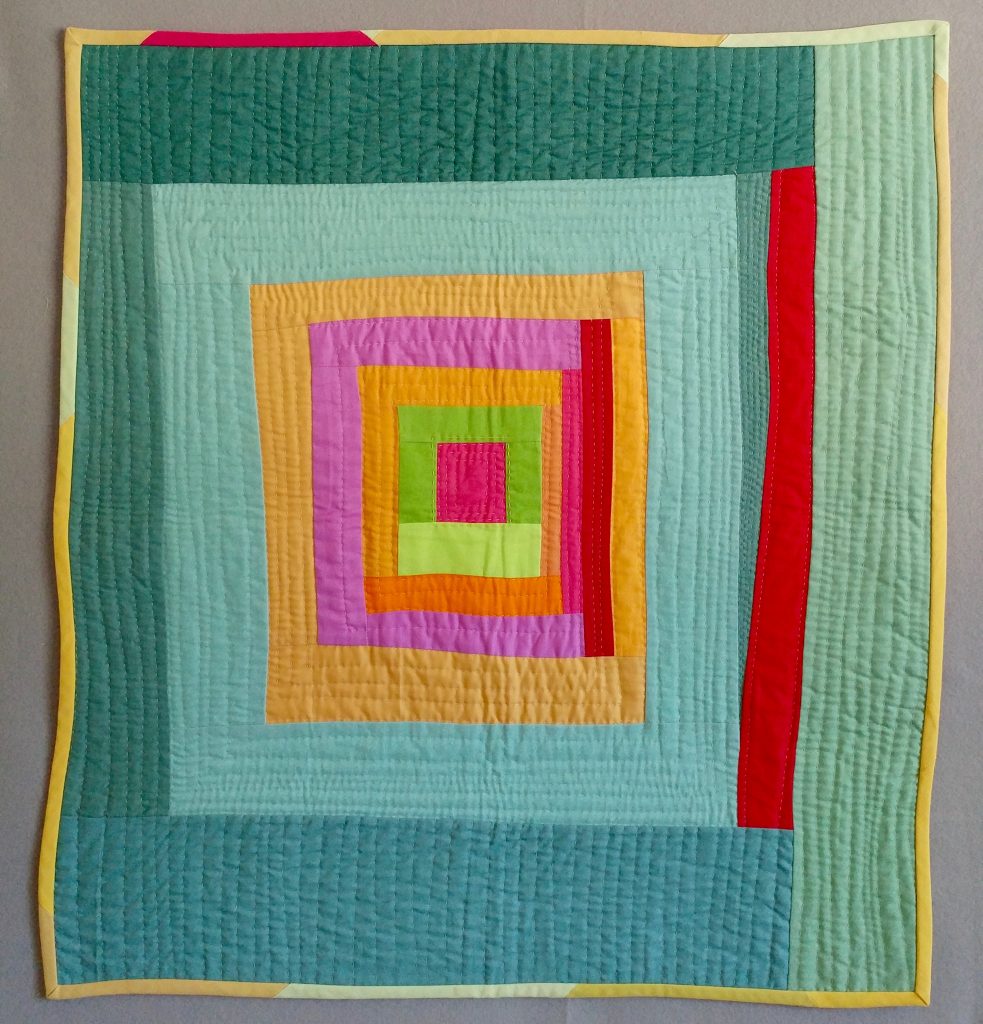
The Kite Festival. Based on Sujata’s memories of growing up in India. Image courtesy of Sujata Shah.
What is the support system you have in place for creating your work?
Sujata: I have been able to create while raising my three children. When family recognizes your need to create, that is the ultimate support.

Organized Chaos. Image courtesy of Sujata Shah.
How do you deal with comparison to / envy of others? Can you describe a time when you used comparison/envy/admiration to push yourself in your own work and self-discovery?
Sujata: I believe in parallel fields in creative world. There is no such thing as reinventing the wheel and there are always multiple ways to arrive at the same destination. In the past I have seen quilts by others that I wanted to make for a long time and I have gotten discouraged that someone else made them first. I have also seen quilts I have made resurface as an original idea. Inspiration is everywhere I look and I am sure that is true for everyone. The human brain stores and releases images brilliantly. The question is, “How do I make my mark in what I do?”
My self-discovery came after seeing the quilts of Gee’s Bend. I felt an instant connection since they reminded me of utilitarian quilts of India. I had been making quilts with perfect seams, matching points and perfectly squared corners for quite some time but seeing African American quilts caused a shift. I copied a few quilts from the book but they did not look as beautiful or as authentic. I needed to be in the mindset of the quilters of Gee’s Bend. Having fewer tools on hand, “making do” with fabric on hand, and accepting imperfection became instrumental to my quilting from there on. I did lot of unlearning. This self-discovery nudged me in the direction of my book, celebrating imperfection of human hands and handmade crafts from around the world.

Improv quilt from Sujata’s book, Cultural Fusion Quilts. Image courtesy of Sujata Shah.
What does it mean to you to work in a traditionally domestic medium that historically has been regarded as predominately female (aka “women’s work”)?
Sujata: To be able to make quilts out of once-discarded clothes and pieces of fabrics is simply beautiful. This traditional domestic medium has come a long way. It was never about just keeping warm; it was an expression of an art form and still is. It is about keeping a journal, having a political voice, expressing yourself, and more. I don’t see it as a gender issue. In India and around the world, for centuries men have been making art with fiber and textiles. In many parts of the world, the community of tailors is predominantly men. It is their profession and livelihood. I hope more men experience this mind engaging and stress-releasing craft. Art has no boundaries, limits or rules. Why should it be any different with quilting?

Cabin in the Woods. Image courtesy of Sujata Shah.
How do you see your current work in the context of quilting history?
Sujata: I have always considered the process of making a quilt more important than the outcome. At this point, where my work ends up in context of quilting history is irrelevant. I am an artist using quilts as a medium, passing by just as many well-known and unknown quilters from around the world. For now, I want to continue enjoying what I do, celebrating life through quilts, making memories, and stitching my life stories one quilt at a time. I hope my quilts encourage people to embrace the imperfections and irregularities of human hands and find humbling beauty within.
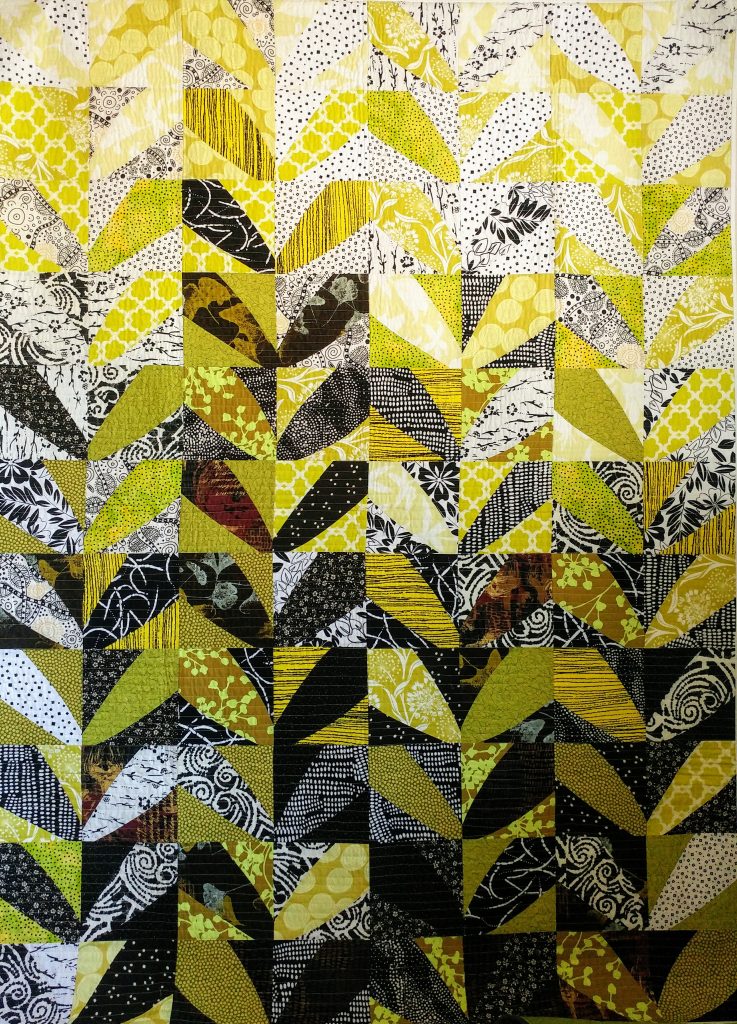
I Dream of Daffodils. Made in the Fall of 2014 when Sujata was looking forward to Spring and new beginnings! Image courtesy of Sujata Shah.
Thank you, Sujata! Your work is so thoughtful and your use of color is so inspiring! For more about Sujata, visit her website The Root Connection, or connect with her on Instagram, Facebook, and Pinterest.
Would you like to be featured in The Creativity Project? Reach out! I’d love to hear from you! Contact me.
Want to participate, but not necessarily be featured? You can do that! Click here to take the survey!
The Creativity Project can be found on Instagram, Pinterest, Twitter or Bloglovin’. Or check back here every Friday of 2018!
Save
8 Comments
Comments are closed.



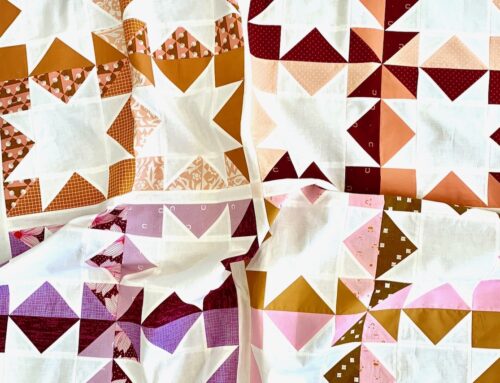

Another wonderful artist – thank you for the introduction, Kim! I really love Sujata’s use of colour and shapes… the quilt for her father is my favourite. Each block has it’s own movement, but then together they look so balanced – it’s really beautiful.
Thank you so much Kirsty! It’s been inspiring to connect with so many different artists and learn about their process and how they “think”. So glad you’re enjoying too!
Sujata…Your quilts make my heart skip a beat with their beauty..xo
They are stunning – aren’t they?
What a beautiful authentic voice from Sujata. It was very interesting to hear about the unlearning and self-discovery, it really shows in the beauty of the quilts.
Thank you Judy! One of the best parts of this project has been learning each quilter’s journey.
Having met her, I can say that Sujata is beautiful inside and out and her words, actions, and quilts reflect her sense of self. Thank you for sharing Sujata through this excellent post!
Thank you Julie! I’m glad you enjoyed and thank you for sharing your thoughts about this wonderful artist.